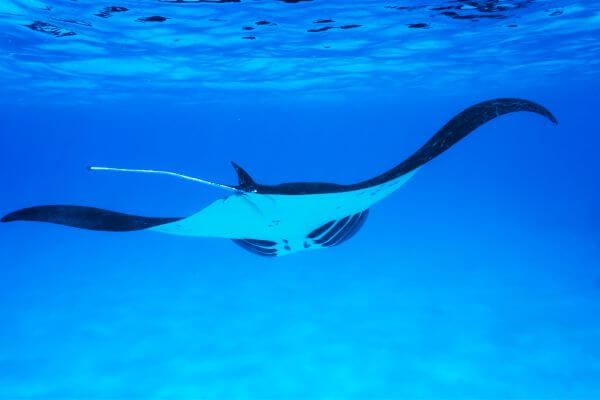Stingrays are graceful animals that have inspired artists, filmmakers, scientists and tourists who want to explore marine life. However, the lack of knowledge about these animals can lead to serious and even fatal accidents in the interaction between humans and stingrays.
In this article, we’ll explore some tips and recommendations for safe interaction, from preventive measures to take to avoid accidents, to what to do if you come across a stingray while in the water.
We’ll also discuss the importance of respecting their habitat, avoiding feeding them, and how you can help conserve these amazing animals. Join us on this journey of discovery and learning.

Understanding behavior: What do I need to know before approaching a stingray?
Stingrays are curious animals and are often attracted by human presence in the water. However, they can also feel threatened and cornered and react aggressively. Therefore, it is important to keep in mind that the interaction must be done with caution and respect for the space of these animals.
One of the main characteristics of its behavior is its camouflage ability. They are able to easily hide at the bottom of the sea, where they are practically invisible to our eyes. This means that, when approaching a stingray, you must be attentive to detect the presence of the animal. In addition, it is important to avoid touching or stepping on the sand at the bottom of the sea, so as not to disturb the animal or provoke its reaction.
Another important aspect is your defense ability. If they feel threatened, they can use their sting to defend themselves. Therefore, it is essential to maintain a safe distance. Understanding stingray behavior and knowing how to act in different situations is the key to safe interaction.
How to recognize the different species and know if they are dangerous?
There are several species with their own physical and behavioral characteristics. In addition, these species can inhabit different environments, from shallow water to the ocean floor. Below are some of the most common stingray species and where they live:
- Cheetah stingray: mainly inhabits the coastal waters and coral reefs of the Pacific and Indian Oceans. It has dark spots on its skin and a venomous stinger on its tail.
- Manta Ray: It is a deep-sea species that can be found in all oceans of the world. It can reach a wingspan of more than seven meters and is harmless to humans.
- Sandpaper stingray: is a common species in Brazilian coastal waters and can be found from the Caribbean to Argentina. It has a poisonous stinger on its tail and is considered one of the most dangerous species.
- Short-tailed stingray: it is a common species on the Brazilian coast and can be found from Florida to Argentina. It has a short tail and a flattened body, making it harmless to humans.
- Ticonha stingray: it is a species found in the South Atlantic, with nocturnal habits and that feeds on fish and crustaceans. It has a venomous stinger on its tail and can inflict painful injuries on humans.
- Torpedo ray: it is a species of shallow waters found in the Mediterranean and the Eastern Atlantic, which has an electrical organ capable of emitting electrical discharges to hunt its prey and defend itself against predators. Electric shock can be dangerous for humans.
Tips to avoid accidents:
- Keep a safe distance: avoid getting too close to the stingrays and respect their space. Remember that these animals are wild and unpredictable.
- If you are walking on the beach, be aware and avoid stepping on stingrays that may be buried in the sand.
- When entering the water, wear shoes that cover your feet to protect them from possible injuries caused by stingrays.
- If you know that a certain area is known to have a lot of stingrays, avoid swimming in that area.
- Never touch a stingray, even if it looks harmless. Remember that these animals can defend themselves if they feel threatened.
- Don’t swim towards the stingray: Avoid swimming towards the stingray as this can startle the animal and make it feel threatened.
- Stay still if you are close to the stingray, and avoid making sudden movements that could startle the animal.
- Wait for the stingray to move away from you before starting to swim again.
- Wash the wound thoroughly if you are injured by a stingray, rinse with salt water and seek medical help immediately. Some types of injuries caused by stingrays can be serious and require proper medical treatment.
Remember that stingrays are wild and unpredictable animals, so it’s important to take precautions to avoid accidents. If you are in an area known to have many stingrays, follow the guidelines of local guides and respect established rules.
The importance of respecting the space of stingrays
It is essential to respect their space for these animals, as they are essential for the ecological balance of marine ecosystems. By disturbing stingrays, we can affect their natural behavior and interaction with other species. In addition, stingrays can feel threatened and defend themselves with their poisonous tail, which can result in accidents and serious injuries to people.
Keeping a safe distance also helps protect stingrays from human activities that could harm their health and well-being, such as pollution, overfishing and habitat destruction. By avoiding disturbing stingrays we are contributing to the conservation of these animals. This ensures a safe and harmonious interaction, while contributing to the protection of stingrays and marine ecosystems as a whole.
Safety equipment and accessories: What to bring to ensure a safe interaction with stingrays?
To ensure a safe interaction, it is recommended that you use appropriate safety equipment and accessories. Here are some suggestions:
- Wetsuit or swimsuit: these clothes help protect the skin from possible scrapes and cuts during contact with stingrays.
- Dive Mask and Snorkel: These pieces of equipment help you see the stingrays clearly and keep a safe distance while you observe them.
- Flippers: Flippers allow you to move easily in the water, avoiding contact with stingrays.
- Neoprene Gloves and Socks: These accessories help protect hands and feet from cuts and scrapes, as well as help maintain body temperature in colder waters.
- Sunscreen: Use a water-resistant sunscreen to avoid sunburn while in the water.
- Diving Knife: Although not required, a diving knife can be useful for removing fishing line or other objects that may be caught in stingray fins.
The dangers of feeding stingrays: why is it not recommended to feed them? And the risks associated with this practice
Feeding wild animals such as stingrays is a practice that should be avoided for several reasons:
- It can cause an imbalance in the local ecosystem, as they may end up becoming dependent on food provided by humans and stop looking for food naturally. In addition, feeding can modify their behavior, making them more aggressive and dangerous to people in the water.
- Inadequate food can cause digestive and nutritional problems, leading to weakness and illness. In addition, feeding by humans can expose stingrays to foods that contain substances that are harmful to their health, such as plastic, which can be confused with natural foods.
- In addition to the risks for stingrays, feeding them can also be dangerous for people. When animals associate humans with food, they can become more aggressive and approach swimmers or divers in search of food, causing accidents and injuries.
Therefore, it is always important to keep a safe distance and avoid any type of food or interaction that could harm the safety of bathers and the animals themselves.
How to support the conservation of stingrays?
Conservation is an important issue to ensure the survival of these animals in our oceans. Many species are endangered due to overfishing and habitat loss. It’s crucial that each of us do our part to help protect these amazing animals. One way to support conservation is to help organizations that work to protect stingrays and other marine animals. You can contribute financially or volunteer in conservation programs.
With small individual actions, such as learning more about these species, supporting conservation organizations and making conscious choices when consuming seafood, we can contribute to the protection of these amazing animals and the marine ecosystem as a whole.
In summary, it is essential to understand the behavior of these animals, and to adopt preventive measures that can guarantee a safe and responsible interaction. In this way, it is possible to learn to live in harmony and enjoy the company of these animals in a safe and enriching way.

